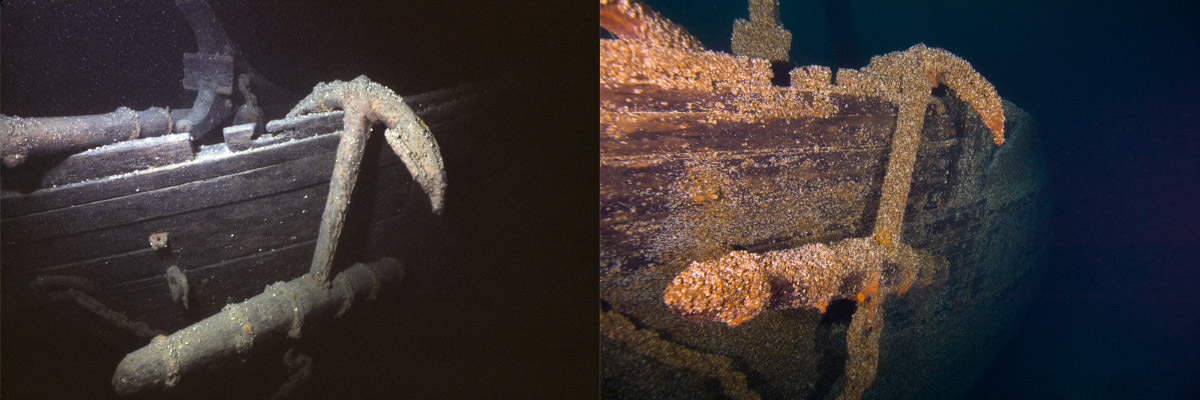Invasive Species
Thunder Bay National Marine Sanctuary

Why is it a concern?
Of the many invasive species in the Great Lakes, zebra and quagga mussels have had the greatest negative impact on sanctuary resources. Additionally, other invasive species that degrade water quality have an indirect effect by potentially limiting physical access to sanctuary resources (e.g., beach closures). While zebra mussels are mostly confined to hard objects and substrates, quagga mussels can also live and thrive on muddy or sandy bottoms and can tolerate a wider range of temperatures and water depths than zebra mussels. Zebra and quagga mussel colonization is causing archaeological resources to deteriorate and hinders the ability to accurately and precisely conduct archaeological documentation.
Both zebra and quagga mussels affect natural ecosystem functions by altering nutrient cycles and re-engineering physical habitat. They are consumptive filter feeders; each mussel can filter a liter of water per day, thereby depleting the food supply for many native invertebrates, including zooplankton and benthic macroinvertebrates. Native declines have a severe impact on the many fish species that depend on them as a food source. Zebra and quagga mussels have an affinity for hard surfaces such as boat hulls, engines, docks, buoys, breakwalls, pipelines and submerged archaeological resources. Their presence on shipwrecks and other submerged maritime archaeological sites constitutes a significant challenge for archaeologists, historians and resource managers, and in many cases reduces a site’s archaeological integrity. Although the long-term impacts to structural integrity of shipwrecks (e.g., due to corrosion or load) is still not clear, it is reasonable to expect that some degree of physical integrity is being lost.
Overview of Research
Thunder Bay National Marine Sanctuary is actively seeking research partners to conduct work connected to Invasive Species as a sentinel issue.
| Project Name | PI and contacts | Links |
|---|---|---|
Coordinated Science and Monitoring Initiative |
NOAA Great Lakes Environmental Research Lab and other partners |
http://www.glerl.noaa.gov/res/projects/csmi_lake_huron/csmi_lake_huron.html |
EPA Invasive Species Information |
EPA |
|
NOAA Great Lakes Regional Collaboration / Invasive Species Overview |
EPA |
|
Great Lakes Commission – Invasive Species page |
EPA |
|
Alliance for the Great Lakes – Invasive Species page |
EPA |
Science Needs and Questions
Assessments are needed to provide baseline data to evaluate the sanctuary’s current state of preservation and plan and prioritize future documentation. They also allow for the initial identification of threats to archaeological sites, such as invasive mussel coverage, natural deterioration, anchor damage, looting and other impacts.
- What non-indigenous and invasive species can be found living in and around the TBNMS?
- How can key non-indigenous species be controlled and prevented from becoming invasive?
- What impacts are non-native species having on the resources of the Sanctuary?
- What appropriate management actions need to be taken as a result of non-indigenous and invasive species?
Education and Outreach Material
Specific user groups are targeted via outreach methods such as watercraft inspection, regulation booklets, waterfront signage and advertising for recreational boaters. There are also various public education and outreach campaigns being implemented at the local, state, regional and national levels to prevent and slow the spread of non-indigenous species. Stop Aquatic Hitchhikers! is a national campaign established by the U.S. Fish and Wildlife Service in conjunction with the task force and the U.S. Coast Guard designed to educate recreational water resource users on non-indigenous species and provide advice on voluntary guidelines for prevention and control. Habitattitude is a national campaign implemented jointly by the Pet Industry Joint Advisory Council, the U.S. Fish and Wildlife Service, and the NOAA National Sea Grant College Program. It targets aquarists and water gardeners in order to prevent the release of unwanted aquarium plants and fish.
References
Bially, A. and H.J. MacIsaac. 2000. Fouling mussels (Dreissena spp.) colonize soft sediments in Lake Erie and facilitate benthic invertebrates. Freshwater Biology 43:85–97.
Gonzalez, M.J. and A. Downing. 1999. Mechanisms underlying amphipod responses to zebra mussel (Dreissena polymorpha) invasion and implications for fish-amphipod interactions. Can. J. Fish. Aquat. Sci. 56:679–685.
Nalepa, T.F., D.L. Fanslow, S.A. Pothoven, A.J. Foley, G.A. Lang. 2007. Long-term trends in benthic macroinvertebrate populations in Lake
Huron over the past four decades. J. Great Lakes Res. 33:421-436. Electronic document available from: http://www.glerl.noaa.gov/pubs/fulltext/2007/20070020.pdf
Office of National Marine Sanctuaries. 2013. Thunder Bay National Marine Sanctuary Condition Report 2013. U.S. Department of Commerce, National Oceanic and Atmospheric Administration, Office of National Marine Sanctuaries, Silver Spring, MD. 80 pp.

